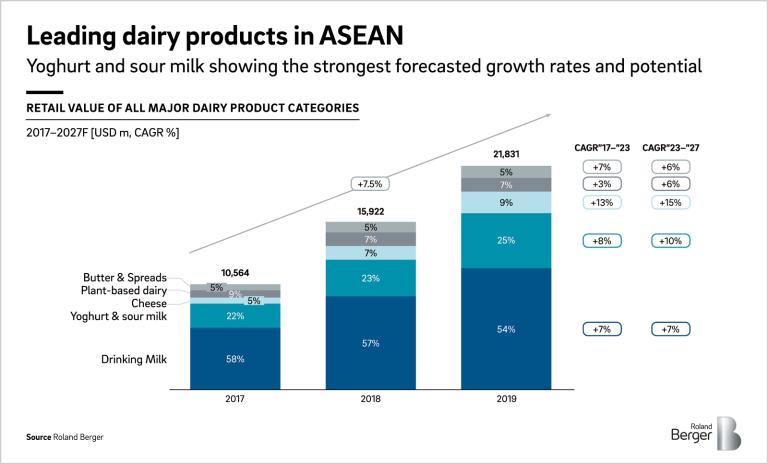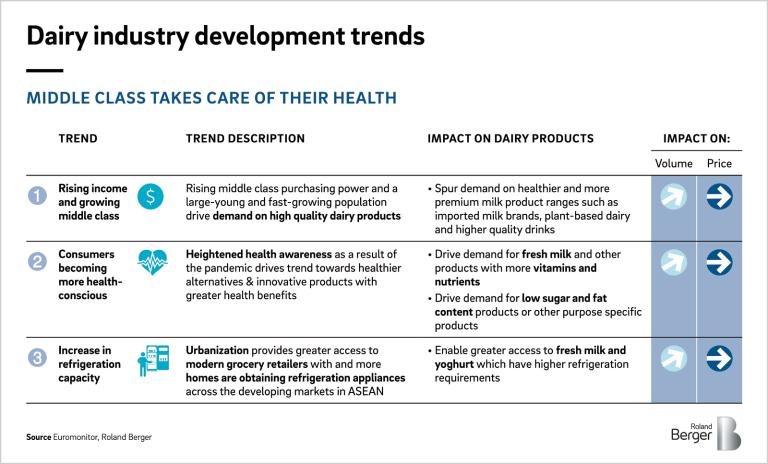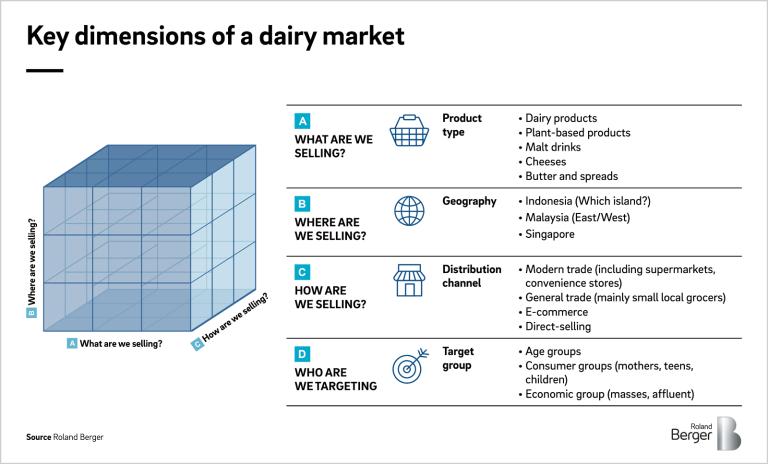

The dairy boom
By Julien Bourdinière and Mani Garg
Southeast Asia's expanding market and opportunities
"The market potential for the dairy industry in Southeast Asia is promising, as key players focus on expanding their product portfolios, embracing new distribution channels, and catering to evolving consumer needs"
As the recovery from the pandemic continues, Southeast Asian markets are experiencing promising growth with consumers increasing their spending and are returning to pre-pandemic lifestyle & consumption patterns.
The dairy industry in Southeast Asia has witnessed significant recent developments, paving the way for an exciting market potential. With a growing population, increasing disposable income, and changing consumer preferences, the demand for dairy products in the region has soared. This surge in demand has led to advancements in production techniques, distribution strategies, and product innovation. The market potential for the dairy industry in Southeast Asia is promising, as key players focus on expanding their product portfolios, embracing new distribution channels, and catering to evolving consumer needs. This article explores the recent developments and highlights the immense market potential for the dairy industry in South-East Asia.
The dairy market in Southeast Asia (SEA) will continue to grow – Vietnam and Indonesia are key markets.
With demographic expansion, increased affluence, and the influence of modern consumerism in SEA countries, we expect the dairy market to display a positive outlook over the next few years, with markets such as Indonesia and Vietnam showing the most promising and aggressive growth trajectories in the region.

Across the different product categories in SEA, drinking milk products (plain milk, flavoured milk, juice milk) still dominate and lead all dairy products. Yoghurt and sour milk products show the strongest forecasted growth rates. From a much smaller baseline, cheese and plant-based dairy are also expected to grow.

"Plant-based" dairy is forecasted to have the smallest growth rate (5% CAGR) over the next few years. In the short and medium term, "plant-based" is expected to have limited market impact and will continue to occupy only a small share of the market due to challenges related to taste, affordability, and perceptions about its nutritional value. The sustainability narrative is also relatively weak in Asia compared to the West. Nevertheless, "plant-based" will continue to be the 'new kid on the block' in the next few years, offering a healthy and sustainable substitute for Southeast Asian consumers.
Strong headwinds in SEA will drive demand for dairy and will also shape consumer preferences.
Spurred by the COVID-19 pandemic, dairy companies have become savvier in communicating the health benefits of their products. Consumers are constantly evolving, and distinct consumer behaviours and characteristics are developing. Thus, the dairy market in SEA is expected to grow, supported by the following tailwinds:

Over the past few years, there have been notable customer shifts in product innovations, prompting competitors to focus on two key areas: localizing flavours and improving their selection of healthier SKUs.
Dairy companies in Vietnam, Thailand, and Indonesia have introduced new and innovative flavours by combining popular choices such as 'aloe vera,' 'matcha,' and 'lychee' into their beverages. They have also incorporated local desserts like 'black glutinous rice,' 'Taro' (sweet potato), and coconut drinks into their popular SKUs.
In addition, consumers are increasingly health-conscious and selective in their choices. As a result, dairy players are innovating with brands and products that promote healthier lifestyles. Products with reduced or zero sugar content are playing a significant role in the expanding market, particularly in urban areas. Plant-based alternatives, including oats, almonds, cashews, and soy, are gaining momentum as popular ingredients to cater to vegan and health-conscious consumers.
Furthermore, dairy brands are offering nutrient profiles and supplementary vitamins to meet the demand for specific nutritional requirements, such as those for children, seniors, and sports and fitness enthusiasts. As an example, in the Philippines, a recently launched brand called Mr. Milk (a collaboration between Del Monte and Vinamilk) introduced two successful drinking milk products: Fresh Milk, which is free from antibiotics and preservatives, and IQ Smart, a fortified drinking milk enriched with Omega 3 and Omega 6, vitamin A, and vitamin B. These products were developed to cater to the nutritional needs of children.
Targeted and innovative digital marketing and investment in sales strategies can give companies an edge.
Dairy players' best practices in sales and marketing can be observed through their investments in sales staff performance management and highly targeted digital marketing and sales strategies.
In markets heavily reliant on GT (General Trade), competitors are establishing robust systems of structured training, monitoring, and performance management. Common practices include setting sales targets, closely monitoring sales staff performance, and providing training to continuously upskill the salesforce. Assessing store visit frequency and in-store activities is essential for identifying areas of improvement. Moreover, establishing effective channels for feedback ensures that valuable insights from customers and staff are incorporated into the sales and marketing strategies moving forward.
To further drive product performance, a highly targeted and digital marketing approach is crucial. This involves tailoring strategies to specific locations and customer segments, leveraging local or international celebrities and influencers, and developing compelling stories that resonate with the target audience. Dairy companies are increasingly utilizing celebrity chefs, "mommy influencers," and YouTube stars to promote their products to each target customer segment. Furthermore, adapting the marketing strategy to each distribution channel optimizes reach and impact. For example, certain dairy companies in Vietnam have bundled their product offerings in MT (Modern Trade) channels, highlighting "hero" products in their marketing campaigns while promoting slower-moving products to boost sales. Additionally, sales and marketing teams are structured to facilitate seamless collaboration across various stages, from research and development to sales, ensuring the prioritization of the right channels and products in alignment with market demands and opportunities.
When formulating a go-to-market (GTM) strategy, companies need to have a clear focus on four essential dimensions: product type, geographical nuances, distribution strategy, and target customers. Without a comprehensive understanding of these dimensions, successfully entering the market can become challenging. Common pitfalls often arise from availability bias, an overly simplistic interpretation of historical growth data, and the failure to anticipate market disruptions.

Distribution and channel strategies are the focus of key players in SEA looking to grow in their markets.
Prominent players are placing a greater emphasis on distribution innovation, which is increasingly vital for driving growth. Especially within distribution innovation, optimizing channels begins with getting the channel mix right. This involves understanding the effectiveness of the current mix and monitoring changes in channel performance. In the SEA region, while traditional grocery channels dominate in terms of outlet volume, modern trade channels are gaining prominence in generating higher sales. Aligned with global trends, smaller format stores, including minimarkets and convenience stores, are becoming the go-to shopping formats, especially with the rising middle-income population. Additionally, improving distribution strategies also involve comprehending the unique dynamics of each geography, including infrastructure and transportation challenges, managing travel time effectively and mitigating supply chain disruptions.
Using an Indonesian dairy player as a case study, the company established a hybrid distribution strategy that combined its own cold chain transportation company, customer distribution networks, and 3PL (third-party logistics) to distribute their products across the many islands in Indonesia. With this strategy, the company successfully ensured a lower cost of transportation, optimized distribution routes, and maintained a very low percentage of returned/damaged goods throughout Indonesia.
Regarding channel strategies, key players in SEA are now focusing on establishing a cost-efficient import/export structure, implementing competitive trade programs by leveraging cost-to-serve, and ensuring they have competitive distributor margins, trade terms, and trade promotions. Some are even embracing new channels and distribution methods, such as e-commerce and direct selling agents (e.g., Miss Cimory agents in Indonesia and Yakult Lady in Thailand), which allow for expanded customer reach and engagement.
In a fast-moving market like the dairy industry, being aware of shifting channel dynamics and being agile will likely provide a much-needed competitive advantage.
Innovation is redefining the dairy industry and bringing opportunities for investors.
In the dairy industry, innovation plays a crucial role in adding value that consumers are willing to pay extra for. This involves creating new products that align with evolving consumer preferences, including healthier options, functional choices, and plant-based alternatives. Investors can capitalize on these opportunities to generate value from the dairy market.
-
1. Product innovation for functional gut-health products.
Increasingly health-conscious consumers actively seek nutritious components in their food and are willing to invest more in their well-being. The functional dairy sector has witnessed significant innovation in ingredients that promote a healthy microbiome, such as pro- and prebiotics. The global demand for these ingredients exceeds current availability, indicating vast opportunities for expansion beyond yogurt products.
-
2. Catering to distinct nutritional needs across different life-stages.
Dairy manufacturers have the potential to develop specialized products that address the specific nutritional requirements of diverse life stages, including children and seniors. Parents prioritize dairy products for children with labels indicating natural ingredients and limited or no added sugar. The incorporation of vitamins and fibre into children's food is increasingly important due to their association with immunity and gut health.
-
3. Expanding horizon of plant-based dairy products.
The plant-based dairy industry thrives due to the growing emphasis on health, sustainability, and ethical food choices. Advancements in food technology, particularly in plant-based cheese, yogurt, and non-soy milk, drive this positive outlook. However, the potential growth of the sector in South-East Asia is hindered by higher pricing primarily caused by limited local production.
In conclusion, the dairy market in South-East Asia is expected to maintain a positive outlook in the coming years, with Indonesia and Vietnam emerging as the most promising growth markets in the region. Notably, there has been a shift in customer preferences, prompting competitors to concentrate on localized flavours and expand their healthier product portfolios. In response to the impact of COVID-19, key players are increasing their investments in sales and marketing strategies, as evidenced by initiatives such as enhancing sales staff training and performance, as well as implementing highly targeted digital marketing approaches. Furthermore, companies are prioritizing the optimization of their distribution channels and strengthening their overall channel strategies. When considering go-to-market (GTM) strategies, it is essential to factor in elements such as product type, competition differentiation, market dynamics, distribution channels, and customer segments. By effectively addressing these factors, companies can position themselves for success and take advantage of the exciting growth opportunities present in South-East Asia.
Register here to get the full ASEAN Private Equity Newsletter.
